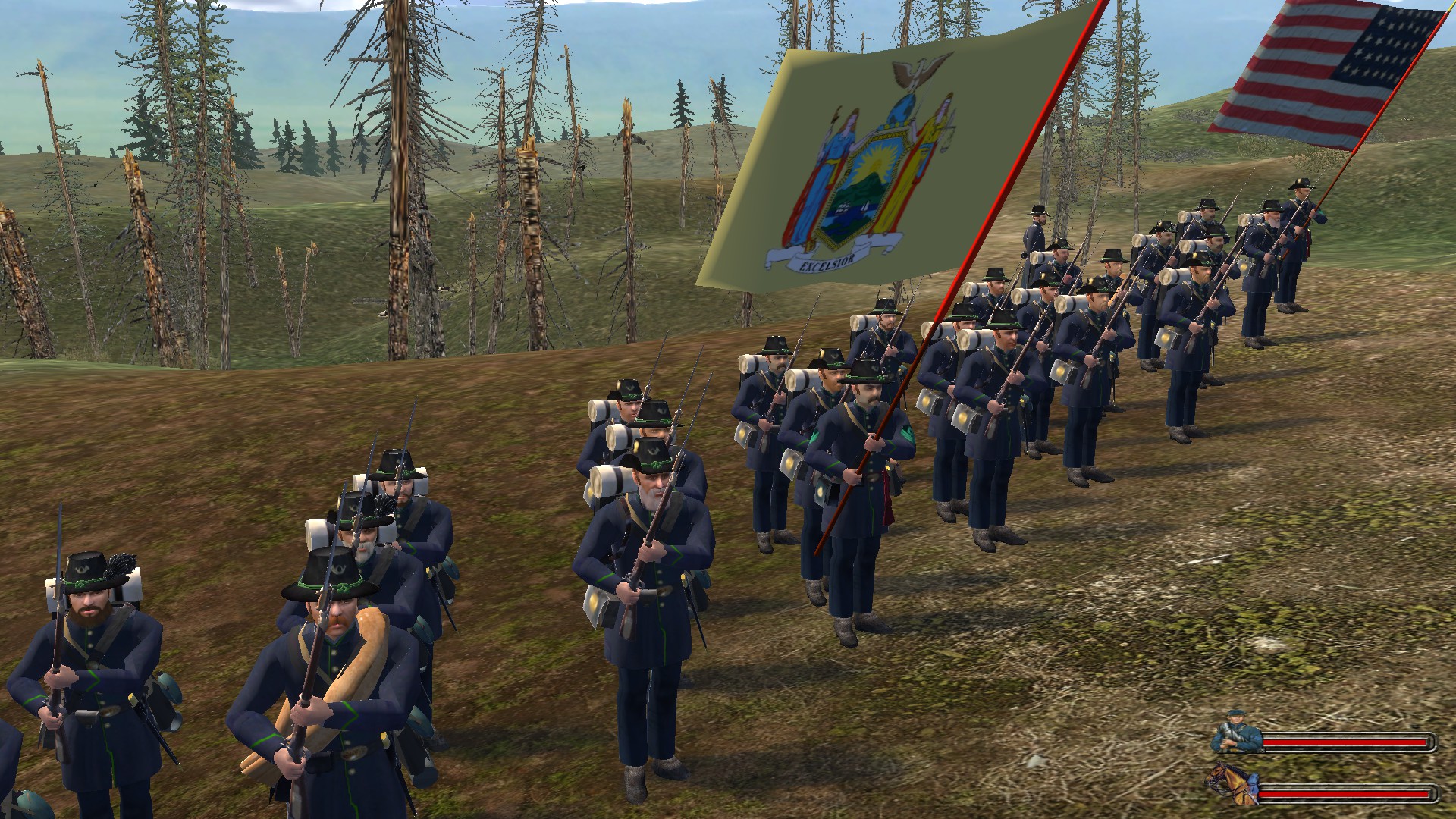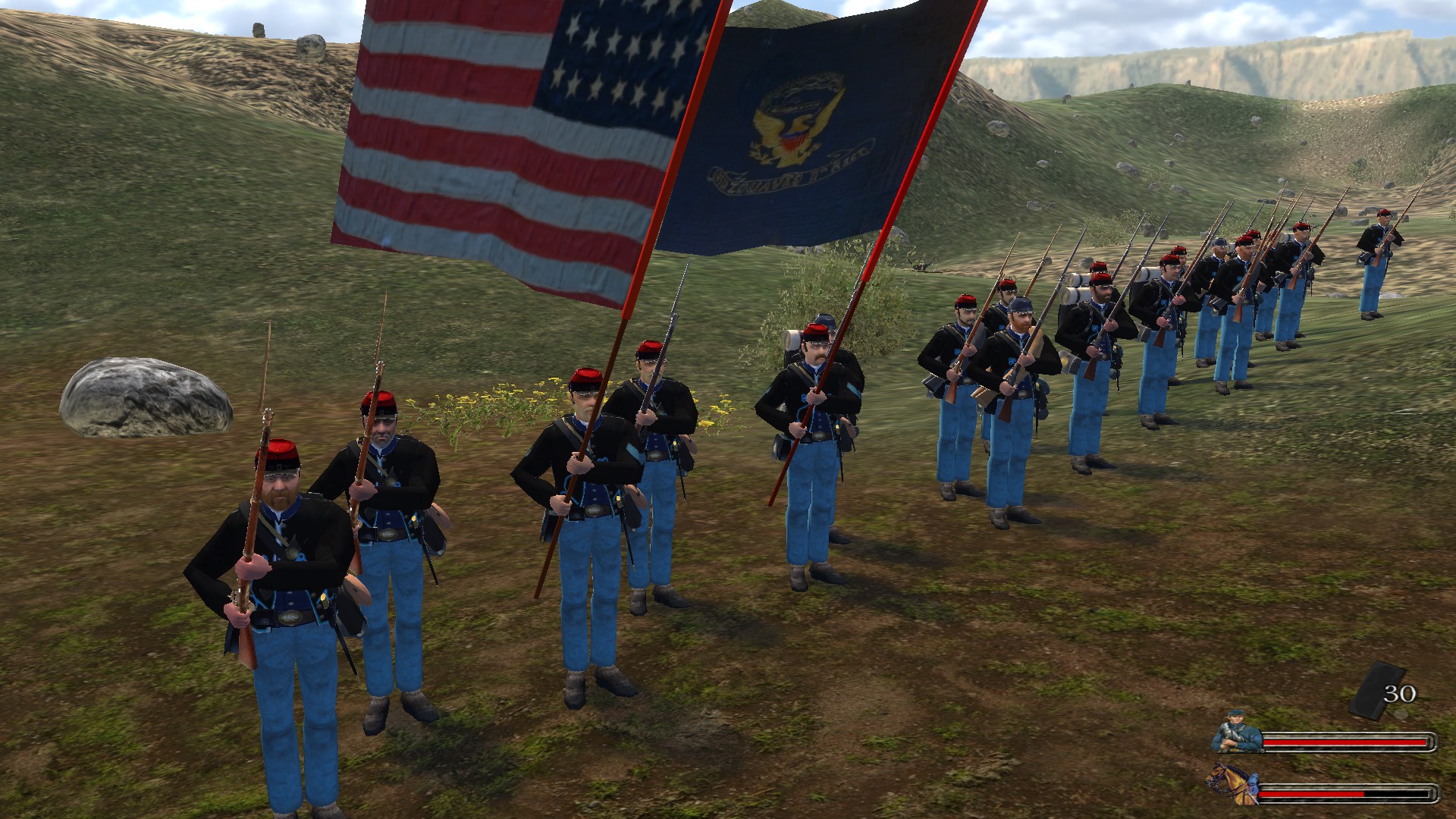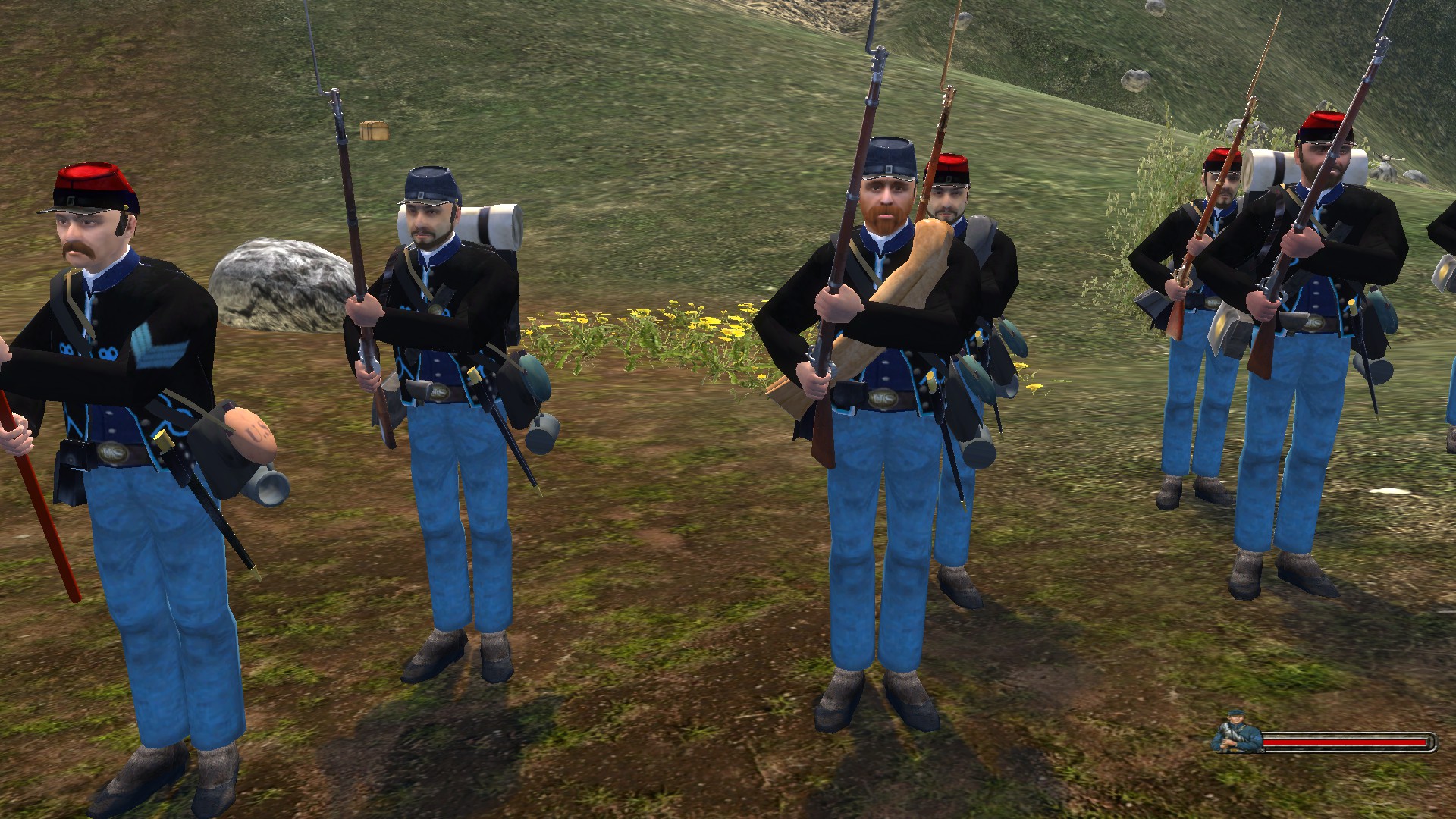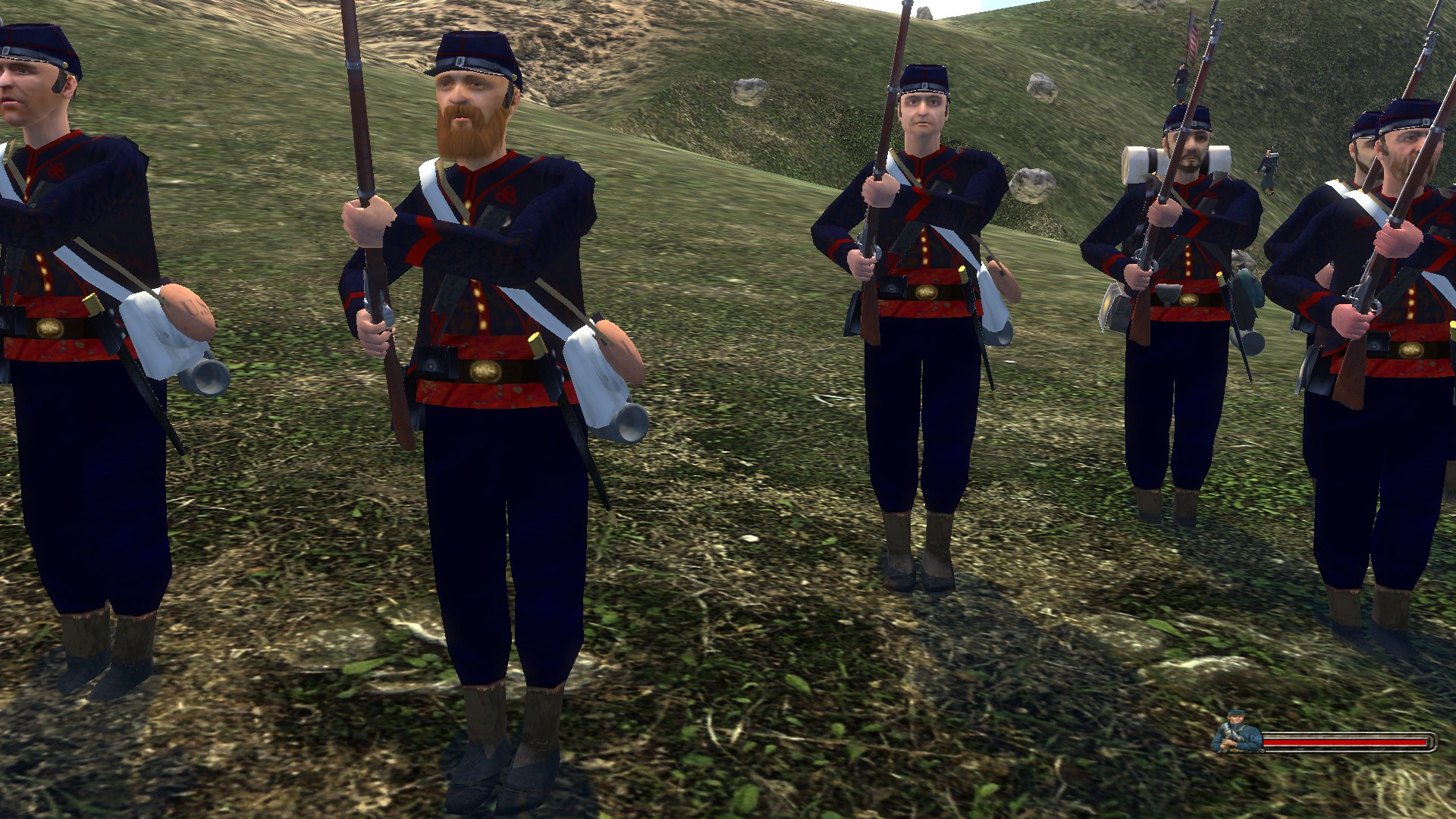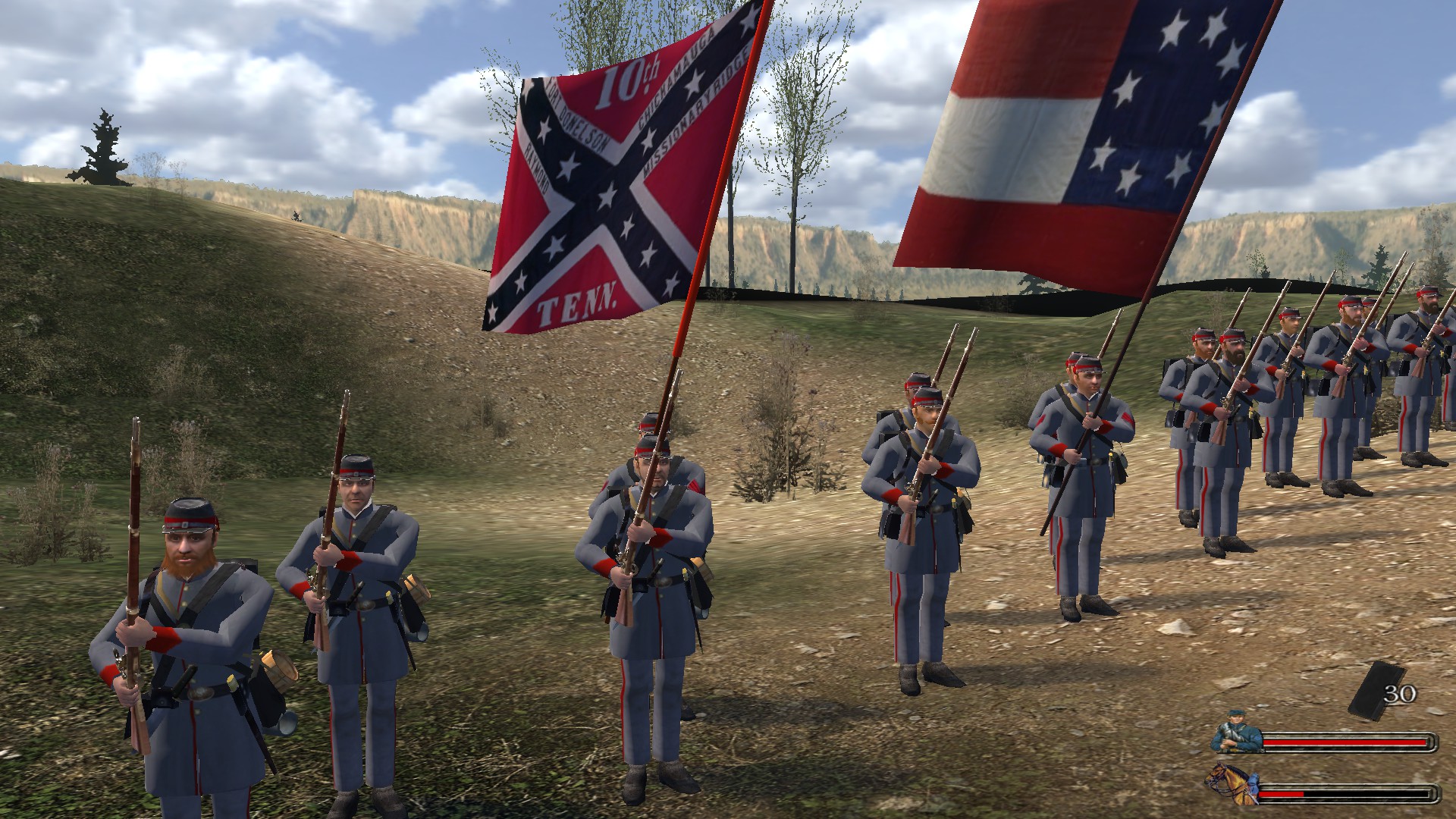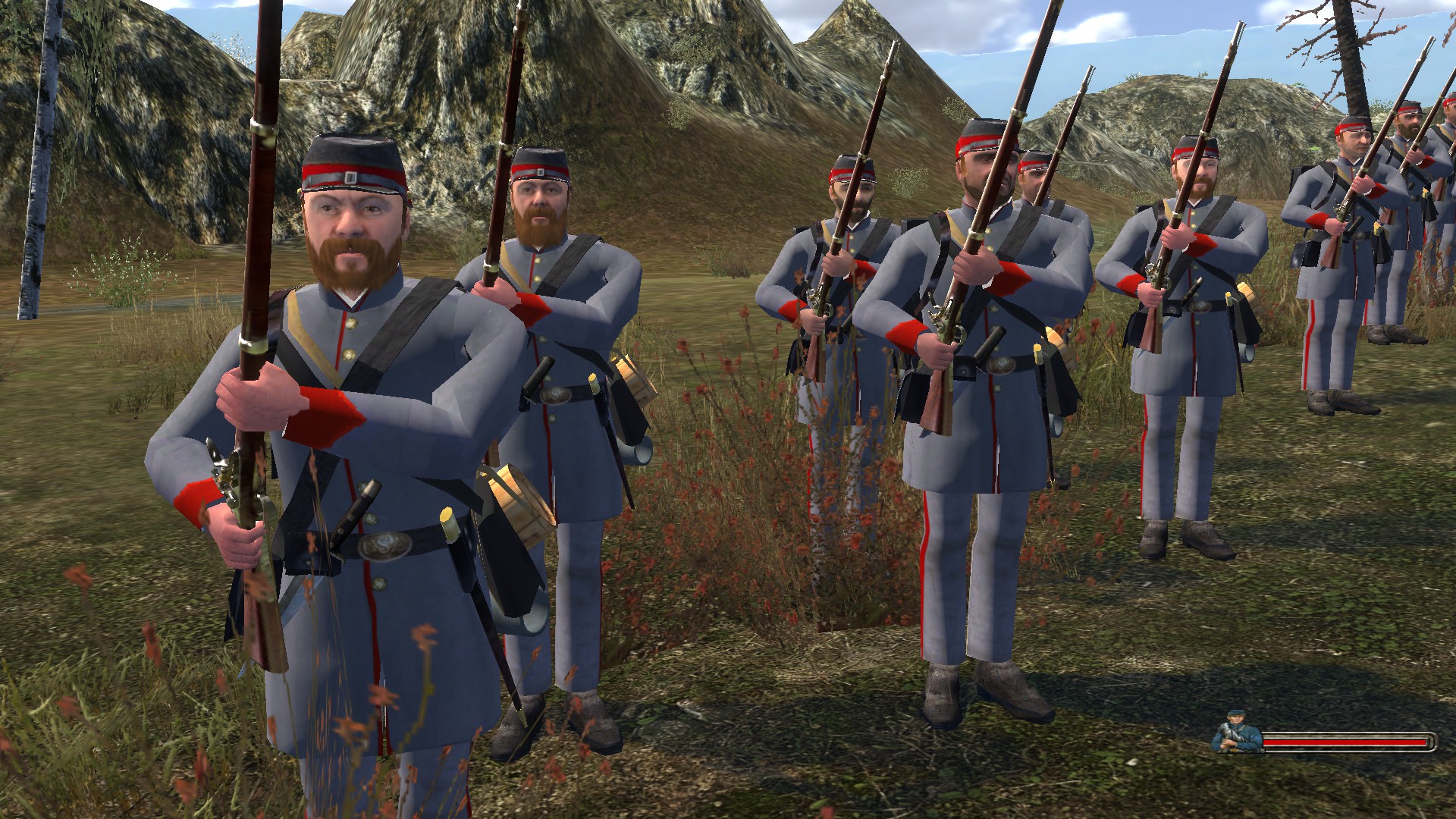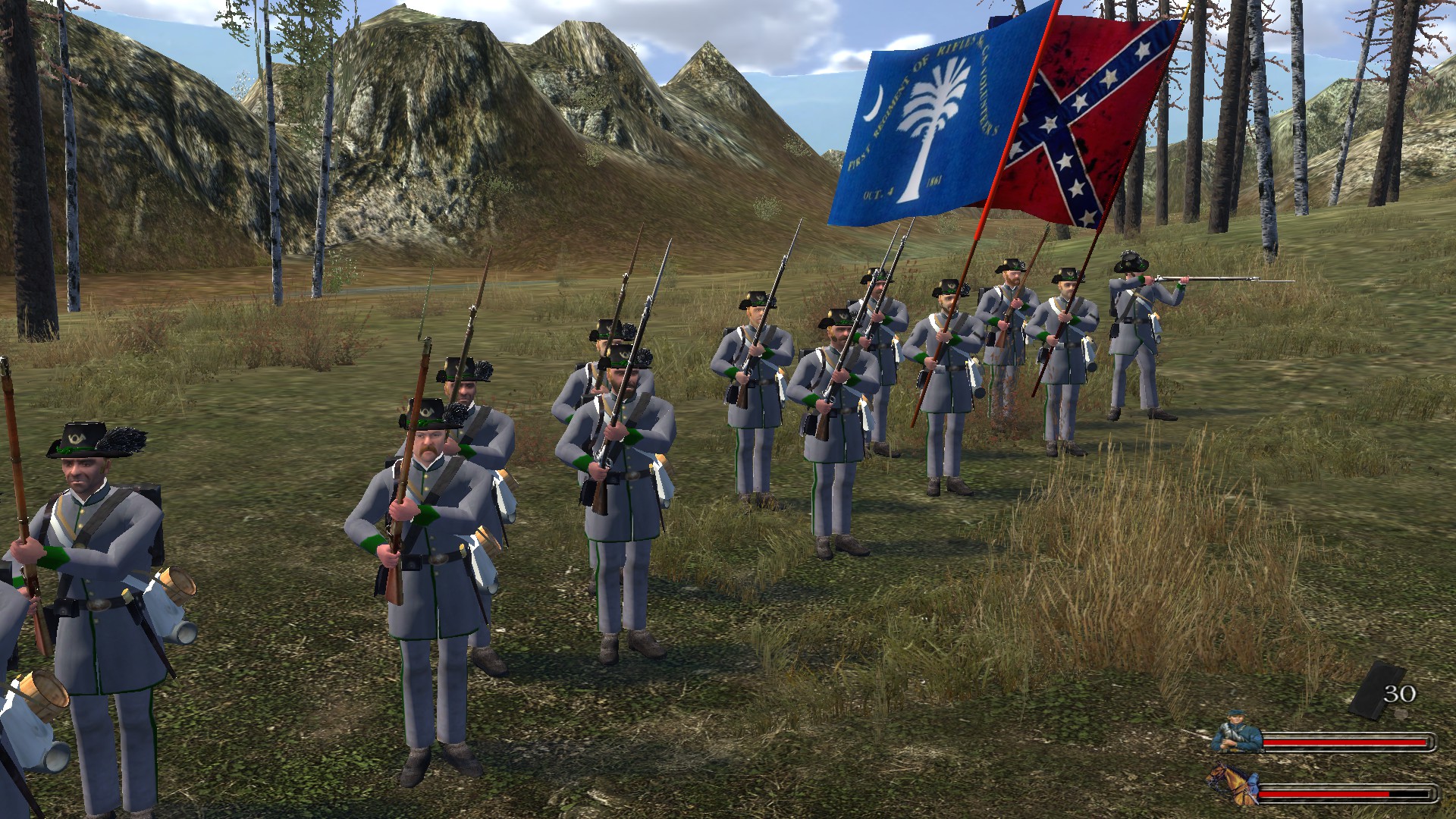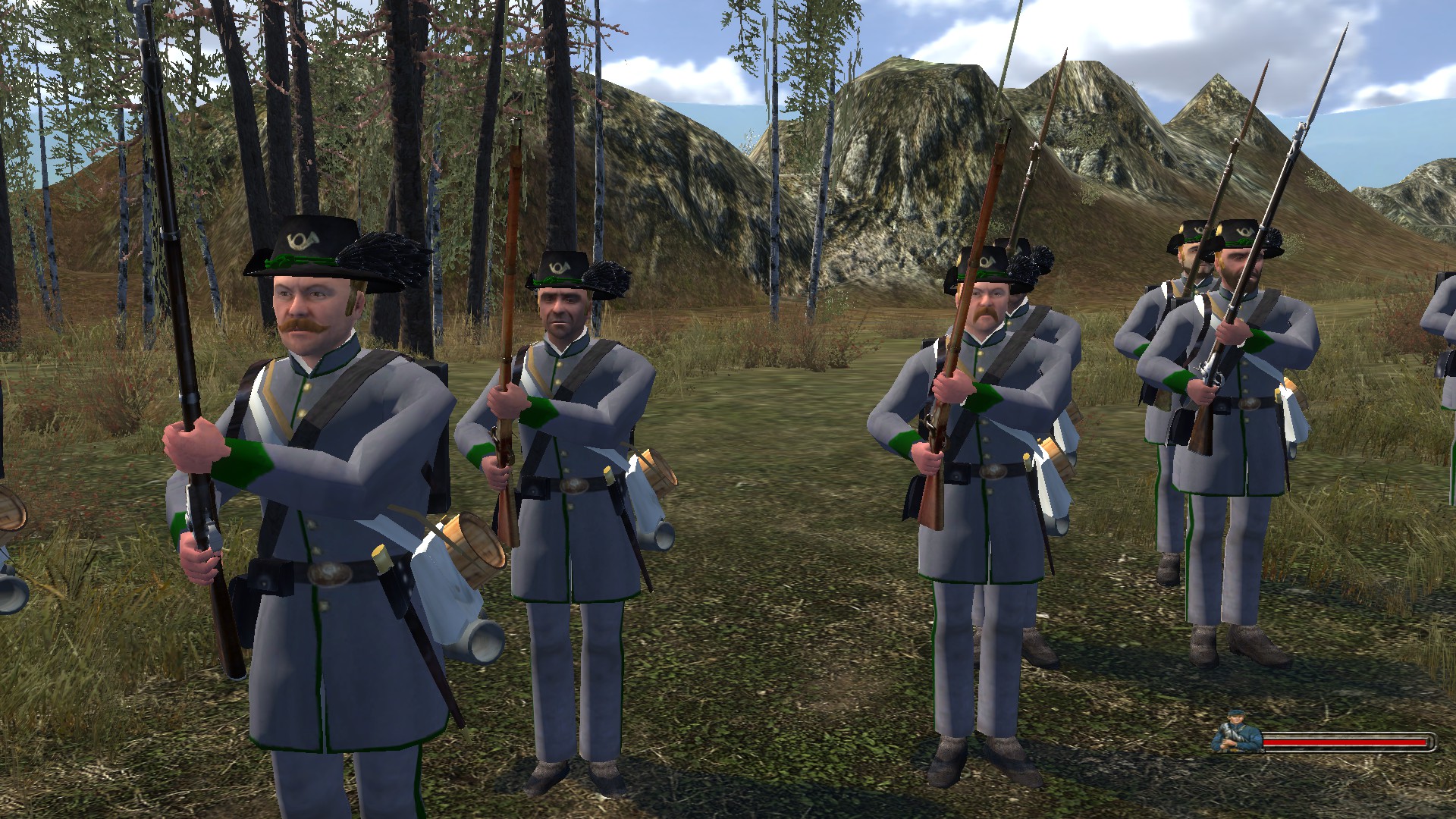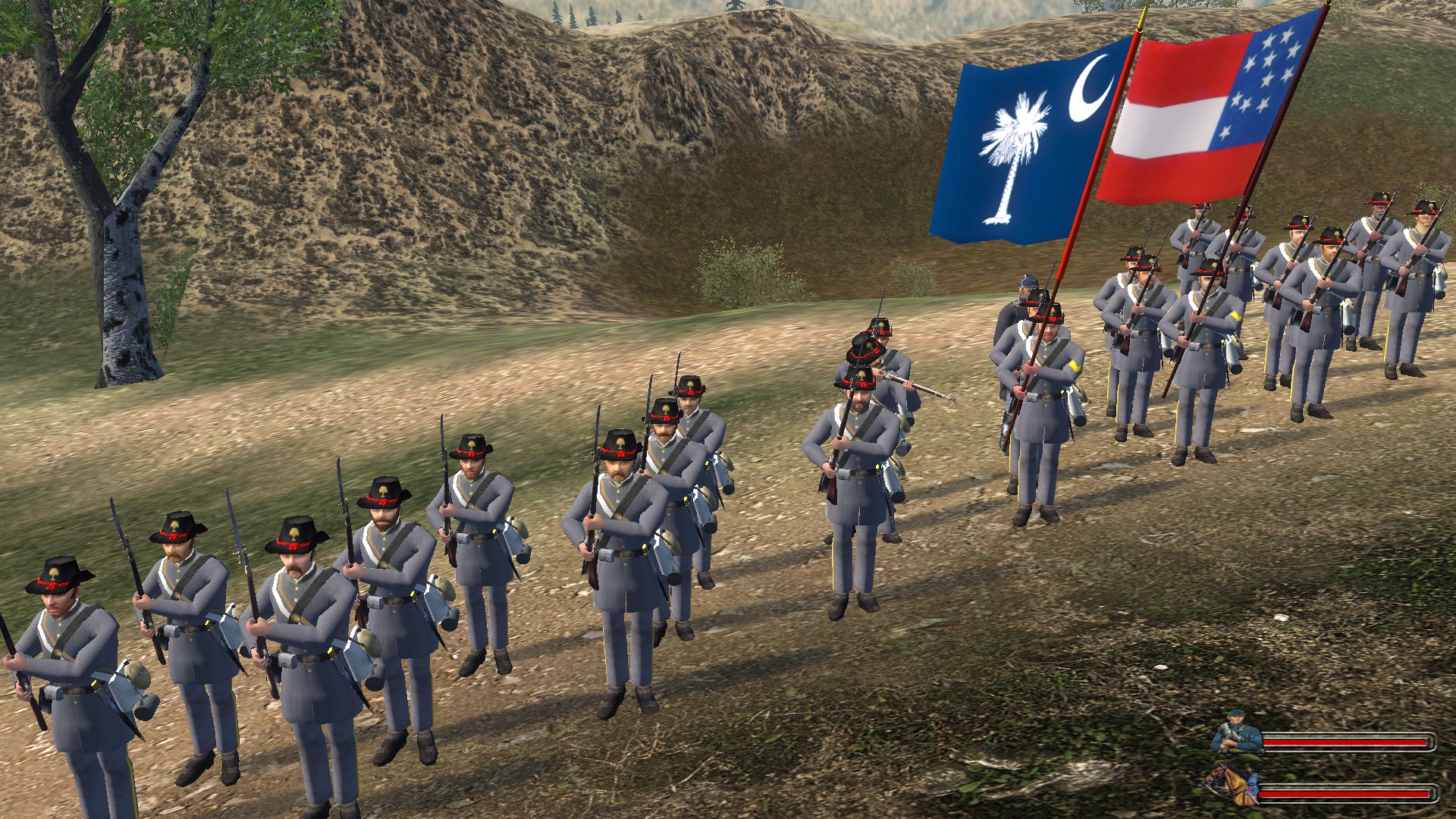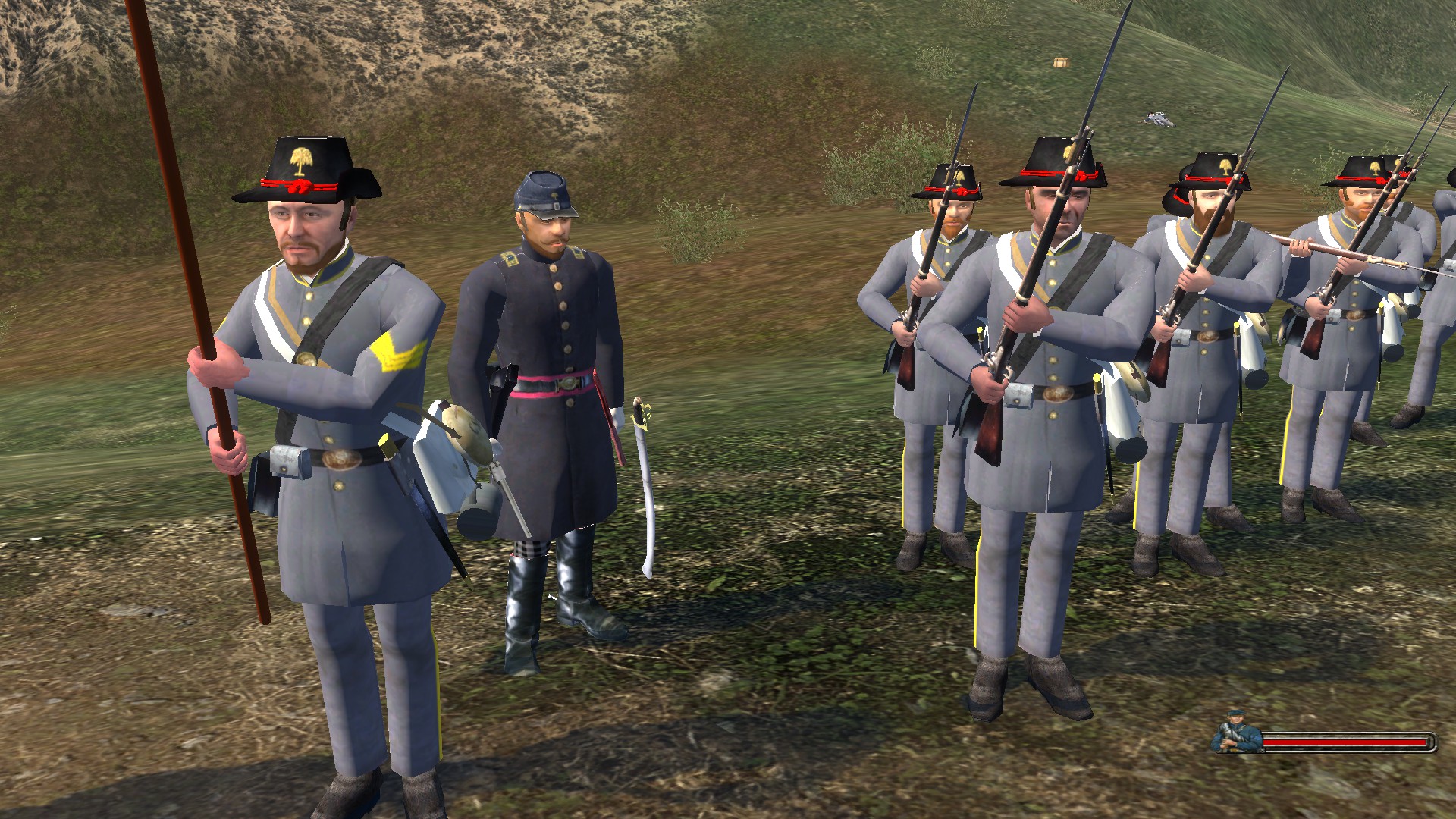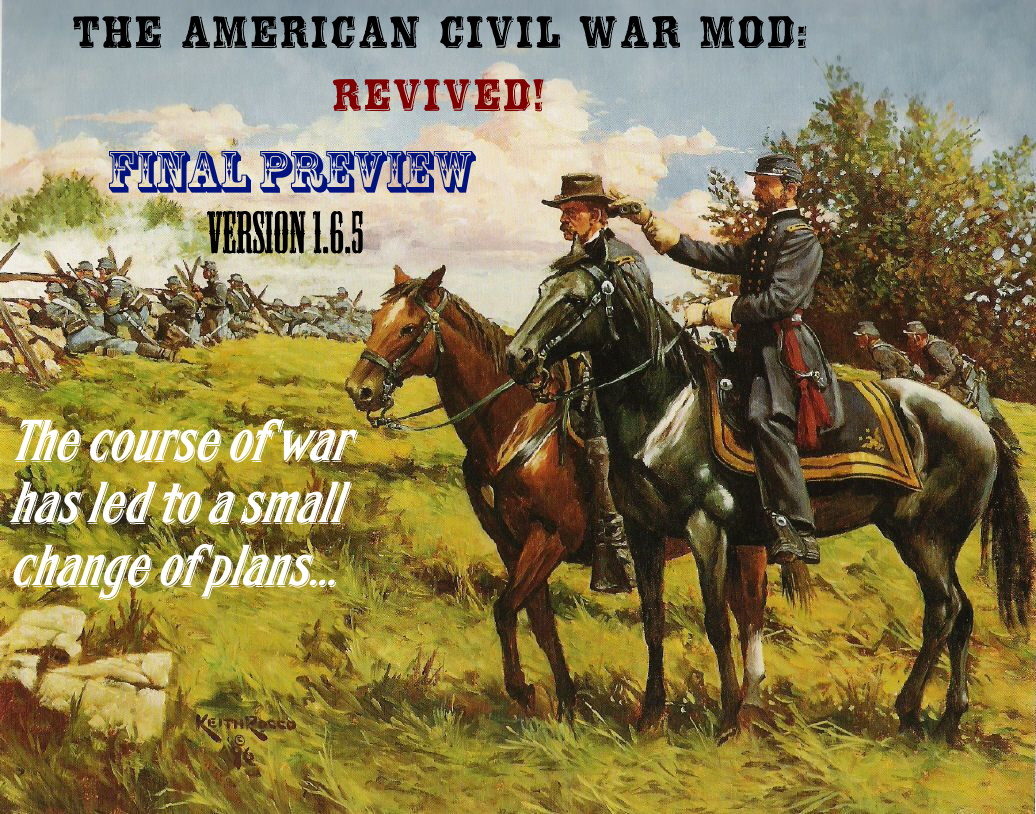
"War is very uncertain in its results, and often when affairs look most desperate they suddenly assume a more hopeful state." ~ Major General George Meade
We have come to the decision that having 12 regiments with their histories is too much for one article, especially with all the other things we wish to include in the release article. So, this article will be a final preview of 3 Union and 3 Confederate regiments, and the last 6 regiments will be revealed with the release of the new update. We hope you enjoy this glimpse at some more of the great new content we have coming, and we are moving full steam ahead towards a full release!
Union:
20th New York Volunteer Infantry "Turner Rifles"
The 20th New York Volunteer Infantry, also known as the "Turner Rifles," was mustered into federal service for two years on May 6th, 1861. Although most of the men were recruited primarily in New York City, several companies of the regiment were formed in upstate New York and New Jersey. The vast majority of recruits came from the various German-American Turner societies, with the largest number coming from New York City's Kleindeutschland neighborhood. Turners are members of German-American gymnastic clubs called Turnverein. They promoted German culture and physical culture, however they were not just athletic but also political and militaristic. Many Turners would fight in the Revolutions of 1848 and favored German Unification, but were defeated. After being suppressed, many Turners would leave Germany and emigrate to the United States, and these migrants would be called "Forty-Eighters". Keeping with their roots, they would become politically involved in America and would support the Union. After the Civil War broke out, many would enlist to fight for the North.
After training in Manhattan's Turtle Bay Park, the regiment left New York for Fort Monroe, Virginia, on June 14th, 1861. They departed with much fanfare, including a parade from Kleindeutschland to their transport ship and the presentation of both an American flag and the Black-Red-Gold flag of Germany's democratic revolutionaries, as well as a guide flag with the motto Bahn Frei, which means "Clear the Way" in German. To the dismay of the enlisted men, in whom was ingrained the German tradition of marksmanship, the regiment was issued with smoothbore muskets, though these would be replaced by rifles in 1862. The Turners were renowned as good entertainers, and for the 4th of July celebration in 1861, the regiment performed several much-praised concerts, with improvised lighting displays and 50 barrels of lager. The Turners were also known to hold gymnastic performances, and their choral singing was very popular.
While stationed at Fort Monroe, General Benjamin Butler commanded a joint army-navy expedition to capture Confederate occupied Fort Hatteras and Fort Clark. In the ensuing Battle of Hatteras Inlet Batteries, a mixed amphibious force led by the 20th New York's commander, Colonel Max Weber, accepted the surrender of the two forts. The landing was a botched affair, in which high seas prevented the majority of the invasion force from landing and left 318 men stranded on shore with inadequate provisions. However, the ensuing Union naval bombardment forced the Confederate garrisons to surrender. The portion of the 20th which had taken part in the invasion remained in the vicinity of Forts Hatteras and Clark for several weeks, until reports reached Major General John Ellis Wool that soldiers from the regiment had committed "depredations and various outrages" on the local civilians. Other sources suggest that the colonel of the 9th New York blamed the looting on the men of the 20th to protect the reputation of his own regiment, which had also participated.
On October 7th, 1861, companies G, H, I & K were ordered to Newport News and on December 22nd, lost 1 officer and 6 enlisted men wounded at the Battle of New Market Bridge, near the town of Newport News. On June 9th, 1862, the 20th New York was transferred to the VI Corps of the Army of the Potomac in preparation for the Peninsula Campaign. The 20th was engaged at the Battle of Savage Station on June 29th, where they were attacked by the 7th and 8th Georgia Infantry, then advanced two miles, followed by a charge on Confederate lines. The regiment was engaged again the next day at the Battle of White Oak Swamp, in which a Confederate artillery bombardment surprised the 20th New York as they were encamped. A significant number of the enlisted men and officers were routed, including the regiment's new commander, Colonel Francis Weiss. As one eyewitness and future Medal of Honor winner in the 7th Maine Infantry remembered, the soldiers of the 20th New York,
"wore high, conical, black hats, and when they broke and ran the plain was dotted far and wide with their hats and knapsacks. It is a tradition in our regiment that they are running still, and their colonel, who days before was talking about the blood he was going to shed, and who certainly led the wild flight several lengths, may not have stopped, for he was never heard from afterwards."
Other officers at the brigade and divisional levels, however, reported that much of the regiment, though startled and disorganized, regrouped in the shelter of nearby woods to await the end of the bombardment. In the days following the debacle at White Oak Swamp, nine officers were forced to resign their commissions, and Colonel Ernst von Vegesack, a Swedish officer who earned the Medal of Honor for his actions at the Battle of Gaines’ Mill, was appointed to command the regiment. The 20th lost 2 killed, 10 wounded and 20 captured or missing in the surprise attack on the camp.
The 20th New York was present for the battles of Malvern Hill, Harrison's Landing, and Crampton's Pass at South Mountain, but was not engaged in major combat until the Battle of Antietam on September 17th, 1862. The regiment suffered heavy losses, losing 9 officers and 42 men killed, 100 wounded and 2 missing, but their performance during the battle earned them praise from their superior officers. Their action in checking the final Confederate counterattack near Dunker Church even earned the praise of the observer who had criticized their flight at White Oak Swamp. From the War Department marker (number 75) on the Antietam battlefield:
"Irwin’s Brigade reached the field about noon of the 17th, formed line across the road at this point, and charged through the Batteries and across the fields in their front to check the advance of the Confederates from the West Woods. The direction of its advance was south of the Dunkard Church and, when its right Regiments, the 33d and 77th New York, were nearly abreast the Church, they received such a destructive fire on their right and rear as compelled them to retire to the cover of the ridge in front of the Church, the remainder of the Brigade forming on their left. Late in the day the 7th Maine charged across the Bloody Lane to Piper’s Barn and was repulsed with great loss. About noon of the 18th the Brigade was relieved by Cochrane’s Brigade of Couch’s Division, and withdrawn to the rear."
The 20th New York went on to participate in the Battle of Fredericksburg from December 12th to the 14th, where they crossed the Rappahonnock river and supported the batteries to the east of the town. After the withdrawal back across the river on the 15th, the regiment moved to White Oak Chapel and went into winter quarters, building huts. On January 20th, 1863, the regiment participated in the Mud March, a failed offensive aimed at trying to approach the Confederate capital of Richmond by crossing the Rappahannock River. The strategy was sound, but it failed because of dissension between generals, compounded by severe winter storms.
As the 20th New York closed in on the end of its two years of service, questions arose as to whether the two years started from the point at which they were mustered into New York service or United States service. On April 29th, 1863, the regiment was involved in maneuvers which would lead to the Battle of Chancellorsville. When ordered to cross the Rappahannock River, approximately two hundred men refused to do so. The mutineers were quickly tried and convicted for mutiny in the face of the enemy, and sentenced to hard labor. Lobbying efforts by Kleindeutschland elites and the support of Army of the Potomac Provost Marshal Marsena R. Patrick led to their sentence being commuted to dishonorable discharges, although these discharges were converted to honorable discharges by a declaration by the war department and a law passed by Congress in 1905. The remainder of the regiment crossed the Rappahannock and participated in the Battle of Salem Church on May 3rd, in which the regiment suffered higher casualties than at any other battle. The next day on May 4th, the 20th fought at the Battle of Banks' Ford and was on the right flank of the advanced Union line of defense, on the high ground just north of the Plank Road. It was attacked by Early’s Brigade and held for an hour and a half of heavy fighting, when Colonel Ernst von Vegesack was wounded. When he fell the regiment broke and ran for the rear. The 20th New York lost 9 enlisted men killed or mortally wounded, 6 officers and 83 enlisted men wounded, and 4 officers and 106 enlisted men captured.
The regiment withdrew across the Rappahannock river on May 5th, and on May 6th, the regiment’s term of service expired. Three years men transferred to the 3rd New York Battery and to Battery F, 5th United States Artillery. The regiment marched to Falmouth Station to board trains for Washington on May 7th, and when they passed through Baltimore on the 8th, they were honored by a torchlight procession by the Baltimore Turnverein. They arrived in New York on May 10th, and mustered out of service on June 10th, under the command of Colonel Von Vegesack, Lieutenant Colonel Schnepp and Major Meyer. Over the course of its service, 8 officers and 53 enlisted men were killed or mortally wounded and one officer and 58 enlisted men died of disease.
In the mod:
The 20th New York Volunteer Infantry wear a dark blue uniform with green trimmings, and they wear a tall black hat with a green cord, and an infantry bugle cap badge on the front. Some of the hats have the brim folded on the side with an eagle badge above it and some will also have black plumes. The regiment is equipped with M1841 Mississippi Rifles and their regimental colors are simply the New York State flag, since an available example of their actual colors does not exist, and the state flag is a fairly close representation of what the flag would have actually looked like. The Turner Rifles, true to their German heritage, are superior marksmen and as veterans of the Revolutions of 1848 are experienced and competent soldiers. Since they fight with bayonets fixed, they are able to hold close ranks on a battle line, where their accurate rifles, and their skill using them, can turn back Confederate attacks with deadly volleys, and if they get too close, repulse them at bayonet point. Since they are a rifle regiment, they are also good as marksmen, fighting in loose ranks ahead of or behind your main battle line. The 20th New York will be found under the Army of the Potomac as an upgrade from the Union Regulars Sharpshooters.
A small side note about their tall black hats, we were able to use this new mesh for other units that wear tall black hats, such as the Iron Brigade, the University Greys, the 10th Indiana, and others. It is a small but noticeable improvement over the old hats.
11th Indiana Volunteer Infantry "Wallace's Zouaves"
The 11th Indiana was enlisted in Indianapolis, Indiana, to serve for 90 days, with Lew Wallace as its colonel and George McGinnis as lieutenant colonel. The regiment was sent to western Virginia and saw only minimal action during a raid on the town of Romney. It then returned to Indianapolis to be mustered out as its enlistment had expired, and was reorganized in Indianapolis for a 3 year term of enlistment, with Wallace and McGinnis returning as colonel and lieutenant colonel. The son of a former Indiana governor, Lew Wallace was a lawyer, a veteran of the Mexican war, and a statesman, and all of this long before he would be known as the author of Ben Hur. While living in Crawfordsville before the war, Wallace organized the Crawfordsville Guards Independent Militia, later called the Montgomery Guards, and during the winter of 1859–60, after reading about elite units of the French Army in Algeria, Wallace adopted the zouave uniform and their system of training for the group. The Montgomery Guards would later form the core of his first military command, the 11th Indiana Volunteer Infantry.
Wallace trained the 11th Indiana in zouave tactics and the regiment became known as Wallace's Zouaves. Their uniforms originally consisted of a grey jacket with red trimming, a grey kepi with red braiding, a dark blue zouave vest, and grey pantaloons, but later they received a new uniform consisting of a black zouave jacket with sky blue trimming, a red kepi with a dark blue band, and sky blue pantaloons. On May 8th, 1861, two stands of colors were given to the zouaves during a memorable ceremony. They were the gifts of the ladies of Indianapolis and Terre Haute. With much cheering and singing of patriotic songs, the banners were given to Colonel Wallace by a Mrs. Cady who had embroidered the eagle on the Regimental colors. After graciously accepting the flags and expressing his gratitude to the ladies, Colonel Wallace turned and dramatically presented the colors to this regiment. "Boys, then, will you ever desert the banners that have been presented to us today?" he asked. The splendidly clad zouaves responded with a deafening, "Never! Never!", and in one of the most dramatic scenes ever witnessed on the Statehouse Square, Colonel Wallace ordered his men to their knees to swear they would never desert the flag of their country or their regimental colors.
The regiment was sent to Paducah, Kentucky and from there joined Ulysses S. Grant's expedition against Fort Henry. Before they went into action, Wallace was promoted to brigadier general and McGinnis became the regiment's colonel. McGinnis led the regiment at Fort Henry and Fort Heiman. The assault began at 11:00 a.m. on February 6th, after traversing dense terrain and a hill top, the 11th Indiana moved into position against Fort Heiman. An account from one soldier states:
“We had to wade across a bay where the icy water came up to our armpits…we put the bayonets on our guns, hung the cartridge boxes on the bayonets and held our guns above our heads to keep the powder dry.”
Despite the mud and the rain the regiment proceeded to its target, capturing Fort Heiman without resistance as the Confederates had evacuated. Environmental hazards from the river combined with weak Confederate fortifications left the engagements at Forts Heiman and Henry relatively light. Regardless, the regiment’s determination to advance in the face of adverse conditions shows how willing and able the zouaves were.
While little conflict occurred at the first two forts, the operation at Fort Donelson proved more difficult. Upon being reinforced by additional Confederate forces, the garrison kept a lively resistance to Grant’s army. Eventually, Lew Wallace’s brigade was ordered in position for operations against the fort, and requests from Wallace to Grant ended with the brigade gaining the 8th Missouri and 11th Indiana regiments from another unit. Wallace had effectively been handed his prized former unit back under his command. The reunification proved effective as the Union right flank against the besieged fort was assaulted by a Confederate breakout attempt on February 15th, with the zouave forces leading a counter attack later in the day. Ultimately, the operation was critical for keeping the Confederates inside the siege perimeter and at the mercy of Grant’s other forces. The 11th Indiana had taken part in a major battle and pushed the enemy back while securing the position for the Union. Wallace noted on the significance of the Fort Donelson experience stating:
“Thirteen thousand prisoners taken, possession of the Cumberland River acquired, making Nashville untenable by General Albert Sydney Johnston, and the military prestige of the South shattered beyond repair, were the results, material, and moral, of the fall of Fort Donelson.”
In March 1862 the Union army was pressing Confederate forces from Tennessee and into Mississippi. With Pittsburg Landing as the main hub of Grant’s forces, the 11th Indiana was stationed at Crump’s Landing, a junction point 6 miles north. This position later proved dangerous as a Confederate counter offensive was directed at Pittsburg Landing in April, resulting in the Battle of Shiloh and leading the 11th into a bit of controversy. On April 6th, Confederate forces under General Albert Sidney Johnston launched attacks against the Union perimeter near Pittsburg Landing. These attacks drove back startled Union troops while putting communications and direction into disorder. During the early stages of the offensive, Lew Wallace realized that fire coming from the Pittsburg Landing region was a sign of intense battle. The march to aid the Union forces put the 11th and the entire brigade at risk since Wallace was unaware that the Confederates were on the offensive instead of the Union. Facing overwhelming numbers, Grant and his officers needed Wallace’s forces to assist in turning back the Confederate advance.
In preparation for combat following the start of the Battle of Shiloh, the 11th Indiana under Wallace was directed to advance on a pre-scheduled route that would take the units toward the forward positions of the Pittsburg Landing perimeter. Since Confederate forces had succeeded in pushing these Union positions back, Wallace was essentially marching his troops into enemy lines until intelligence and scouts indicated the Confederates were actually on the offensive. Upon receiving this news, the 11th Indiana and other forces were withdrawn back towards a secondary road called the River Road, which would allow Wallace to meet up with the flank along the Pittsburg perimeter. This diversion led to a seven hour delay in meeting up with Grant’s command, creating a controversy on the slow arrival of Wallace’s forces. In spite of the strange coincidences that led to the 11th being left out of the first day of fighting, the regiment quickly fought to preserve Indiana honor on the second. Facing off against Confederate forces on the right flank of the Union defensive line, the 11th was tasked with pushing Confederate forces back. By the end of April 7th, the 11th Indiana had achieved victory at the cost of losing 11 men killed and 52 wounded. The dedication of the 11th was noted by many including Lew Wallace, who stated in his report:
“Not one man, officer or soldier, flinched, and Ohio, Indiana, Missouri, and Nebraska will be proud of the steadfast Third Division, and so am I.”
After Shiloh, McGinnis was promoted to brigadier general and Daniel Macauley became regimental colonel. Macauley led the regiment during the Vicksburg Campaign and the subsequent siege of Vicksburg. To secure the Mississippi River, the Union had to capture the strategic heights. Located on a 200 foot bluff on the eastern bank of the Mississippi river, the position gave the Confederates advantages in overlooking the river with artillery fortifications. The necessity to capture Vicksburg constituted a major offensive by General Grant’s forces in mid-1863, with the 11th Indiana becoming involved in two crucial attacks against Port Gibson and Champion’s Hill. While other army units concentrated on the city of Vicksburg directly, the 11th was assigned to the XIII Corps under the command of John A. McClernand. In this role the 11th Indiana was initially engaged against outnumbered Confederate forces at Port Gibson on May 1st, resulting in a heated exchange as the Union armies attempted to secure a strategic position against the Vicksburg fortifications. It was during this time that the 11th was actively engaged with Confederate forces, pushing them back and securing an artillery battery in the attack. The resulting pressure on Port Gibson motivated southern officials to send reinforcements around Jackson, Mississippi to provide support against the growing amphibious operations of General Grant. Poor communication and timing, however, left the Confederates at a sharp disadvantage, sending the reinforcements into conflict with Union forces in between Port Gibson and Vicksburg in the Battle of Champion’s Hill on May 15th.
While the 11th Indiana had captured Confederate positions at Port Gibson, the confusion in the operations against Champion’s Hill left both armies in slight disarray. Heavy fighting ensued as a pivotal point in Grant’s offensive was held up against Confederate counter attacks. The 11th experienced heavy fighting during this time in which Confederate forces were unable to continue their advance away from the Vicksburg fortifications. In all, the unit suffered around 150 casualties from the fighting. A gradual retreat led to the concentration of Union forces in the area, consolidating the beginning of the siege of Vicksburg. After reorganizing the front lines against the fortifications against Vicksburg, the strategic position favored Union forces as the Confederates no longer had an exit strategy. The resulting siege left the 11th Indiana building up defensive positions under enemy fire in and around the perimeter. Despite the resistance, the Confederate position proved too difficult to continue holding, resulting in the surrender of Confederate forces with considerable materials by July 4th.
After the fall of Vicksburg, the 11th Indiana was transferred for duty in the Department of the Gulf, where around this time the regiment was recovering from an apparent smallpox outbreak that had infected the regiment’s camp in early 1864. In July, 1864 the regiment was ordered to Washington, and joined Philip Sheridan's Army of the Shenandoah. In his orders to Sheridan, Grant specified the importance of the region and how the operation was to be carried out stating:
“Give the enemy no rest. Do all the damage to railroads and crops you can. If the war is to last another year, we want the Shenandoah Valley to remain a barren waste.”
This style of total war was different from other actions by the 11th. Instead of operating against enemy formations, they were now tasked with rooting out Confederate forces and removing their ability to make war as well. The task of securing the Shenandoah Valley proved to be a difficult and drawn out operation. A strategically isolated portion of the Eastern Theatre, the valley was typically only ten to twenty miles in width, surrounded on each side by rugged terrain, which provided the Confederacy with substantial cover from Union troops while also supplying vast resources in terms of food and transportation routes. The environment proved vital in previous engagements and would require extensive effort to secure it. To counter these obstacles, General Sheridan influenced his troops to follow a scorched earth approach to removing Confederate installations and resources from the valley. These actions led to the overwhelming destruction of Confederate infrastructure in the entire region.
Although a majority of the scorched earth tactics were employed by Sheridan’s cavalry, the 11th Indiana was involved in a series of decisive operations in late 1864 that helped to secure the valley against Confederate defenses. Victories at Winchester, Virginia, on September 19th, Fisher’s Hill on the 22nd, and Cedar Creek on October 19th all meet with considerable success as the Confederate war effort ground to a halt. Against substantial losses, around 125 casualties over the course of the three major battles, the 11th Indiana had played a conspicuous role in supporting Sheridan’s operations.The results of the Shenandoah campaign were outstanding; the operations at Cedar Creek had effectively removed Confederate forces as a threat to Union expansion while putting the Confederate forces that remained in dire conditions.
The men of the 11th Indiana Volunteer Infantry were transferred to Baltimore, Maryland on January 7th, 1865 and remained on station there until being mustered out by the end of the war on July 26th. Major General Wallace had the honor and responsibility of presenting the battle flags of Indiana's regiments to the State of Indiana for safekeeping. His words on that occasion to Governor Morton were:
"...I have the honor to give you back their flags, with the request that measures be taken by the next General Assembly to preserve them immemorially. ...Put them away tenderly."
In the mod:
The 11th Indiana Volunteer Infantry wear the second style of uniforms that were issued to the regiment, which consists of the black zouave jacket with light blue trimmings, regular Union blue trousers and either a red kepi with dark blue bands, or a plain blue kepi. They are equipped with Springfield Model 1855, 1861, and 1863 rifle muskets and since there is a surviving example of their actual regimental flag, their flag in the mod will be the same. Wallace's Zouaves are an eager and steadfast fighting force, determined to maintain the honor of their home state. The regiment is one that can be counted on in a tough fight and will serve well, whether you need them to hold a firing line, skirmish ahead of other regiments, or to make a bayonet charge, the 11th will get the job done or die trying. The 11th Indiana will be found under the Army of the Mississippi as an upgrade from the Union Veteran Volunteer Zouaves.
33rd New Jersey Volunteer Infantry
The 33rd New Jersey Infantry Regiment was organized at Newark, New Jersey for three years service under an authorization issued to Colonel George W. Mindil, formerly of the 27th New Jersey, being the first veteran regiment raised in conformity to the conditions of the new system, permitting the recruiting of "veteran volunteers." Fully three-fourths of the men of the regiment were represented by the counties of Essex, Morris, Passaic and Hudson. Liberal bounties being offered at this time, the work of recruiting made rapid progress, and the regiment mustered into the service of the United States on September 3rd, 1863, only 55 days after the rendezvous at Newark was opened. The command was in all respects a superior one, seven-eighths of the officers and three-fourths of the men having already seen service in the field. Lieutenant Colonel Fourat had participated in all the battles of the 1st New Jersey Brigade; the adjutant had served acceptably with the 27th; while the entire field and staff, and most of the officers of the line, had previously held commands equal in importance and responsibility to those they now filled. The regiment was uniformed in the zouave dress and armed with the best Springfield rifles.
On September 8th, under orders from the war department, the 33rd broke camp and the next morning embarked on transports lying in the Passaic for Washington, crossing on the 13th into Virginia and two days afterward marching for Warrenton, taking with them a train of 30 wagons loaded with supplies and ammunition. Being transferred to the Army of the Cumberland it fought its first battle at Chattanooga, Tennessee in November, 1863, at which time the aggregate loss of the regiment, considering the work accomplished, was not large, amounting to one officer killed and two wounded, and one enlisted man killed and 12 wounded. The regiment also took a prominent part in the following two days' heavy fighting at the Battle of Chattanooga, where the men of the regiment who had little experience acquitted themselves with the bravery and tenacity of their older, veteran comrades.
Entering upon Sherman's Atlanta campaign, the 33rd New Jersey performed valiant service at Mill Creek Gap, losing two officers and four enlisted men killed, and two officers and 23 enlisted men wounded, with several of the wounded subsequently dying. At Resaca the loss to the regiment was three men killed, one officer and 24 enlisted men wounded. In the eight days' fighting at New Hope Church the 33rd lost one officer and five enlisted men killed and 27 wounded, and it lost in the battle of Pine Knob one officer and 13 men killed, and one officer and 43 men wounded, the total casualties of the regiment during the campaign thus far being 8 officers and 139 enlisted men. After this engagement the 33rd participated in the skirmishes of Nancy's Creek and Muddy Creek, and in protecting the flank of the assaulting columns of the IV Corps at Kennesaw Mountain. At the battle of Peachtree Creek the loss to the regiment was over 70 in killed and wounded, Lieutenants Downes, Aspen and Warren being taken prisoners by the Confederates, and Aspen being badly wounded. Heavy works were now constructed and the 33rd New Jersey was under constant fire for over a month, performing the heavy duty of the trenches and the dangerous one of picket. The regiment left Chattanooga with over 500 men, and entered Atlanta with a few over 100, having lost 300 in killed or wounded. The small remnant marched to the sea with Sherman, participating in the siege of Savannah, and then after a month's rest continued the march up through the Carolinas.
At Averasboro, North Carolina, a few divisions of the Confederate army engaged the 1st and 3rd Divisions of the XX Corps, but after a brilliant fight were compelled to retire, when the army was advanced cautiously on near and parallel roads and the trains heavily guarded. The regiment participated in the battle of Bentonville and Johnston's surrender followed in due time, after which the homeward march commenced by way of Weldon, Five Forks, Richmond and Fredericksburg, the regiment reaching Washington in time to participate in the Grand Review of the Armies of the Republic. The 33rd New Jersey was retained in service until August 2nd, staying near Alexandria, and was then mustered out and proceeded to Newark. The total strength of the regiment was 2,184, and it lost a total of 163 men during service; 6 officers and 72 enlisted men were killed or mortally wounded, and 85 enlisted men died of disease. 582 men were lost to desertion, 2 were dismissed , 59 were discharged, 12 resigned, 223 transferred out of the regiment, 41 were promoted and served with other units, and 79 remain unaccounted for.
In the mod:
The 33rd New Jersey Volunteer Infantry wear a dark blue zouave uniform with red trimming, and have either a star or a crescent on the left chest of their zouave jackets, as well as wearing slightly baggy dark blue pants with black boots and gaiters. Their kepis are the same dark blue color, with red trimmings. A surviving example of their regimental flag was too damaged to use, however it was simple enough that I was able to use an existing flag already in the mod and add the appropriate markings for the 33rd New Jersey, and thereby make a fairly good copy of the real thing. The regiment is equipped with Springfield Model 1863 Rifle Muskets, the best Springfield's available. Being a regiment made up almost entirely of veterans, the 33rd New Jersey is a formidable line infantry unit. These veteran soldiers, being all armed with the best rifles available to the Union, put them on par with some of the strongest units on either side. The 33rd New Jersey will be found under the Army of the Potomac as an upgrade from the Union Regulars Skirmishers.
Confederate:
10th Tennessee Infantry "Bloody Tinth"
The 10th Tennessee Infantry was organized at Fort Henry, on the Tennessee River, in May of 1861, just a few weeks after the first shots were fired at Fort Sumter. In July 1861, the 10th Tennessee was reported with 720 men armed with flintlock muskets, comprised of men from the Nashville area, as well as the Humphreys, Giles, Davidson, and Montgomery counties of Tennessee. Known as the “Bloody Tinth”, it was one of only two Irish Catholic regiments in the Confederate Army, although their elected officers were mostly Ulster-Scots Protestants. The Regimental flag originally belonged to Company D of the Tennessee State Militia, and was outlined in Kelly Green on a light green background. A gold harp, maroon trim with white lettering; above the harp, “Sons of Erin”; below the harp “Go Where Glory Awaits You”.
Initially serving at Fort Henry, the 720 men of the regiment were transferred to Ft. Donelson where it was part of Colonel Heiman’s command which was surrendered in February 1862. Those taken prisoner at Donelson were eventually paroled at Vicksburg in September 1862 and the regiment was reorganized a short time later, with Randall McGavock replacing the deceased Colonel Heiman. The 10th was under fire at Mechanicsville, and took part in the desperate assault of Longstreet’s Division on the enemy’s position at Gaines’ Mill, and emerged victorious, but at the loss of half of the 350 men that were engaged. Three days later, the regiment was in the line of assault at Frazier’s Farm, where it met Meagher’s 69th New York, the famed Irish Brigade. Of 180 men fit for duty, only 90 were present at regimental muster the next morning. The 10th again saw action at Chickasaw Bayou against General Sherman's forces in late December, 1862. The regiment's ranks soon began to fill up once more, and the 10th Tennessee marched with the Confederate army towards the Potomac river.
At the Second Battle of Manassas, the 10th Tennessee suffered under a destructive fire, and lost about 60 men, but was held in reserve. The regiment took part in the capture of Harper’s Ferry, then crossed the river and fought obstinately at the Battle of Antietam, where it lost 67 killed and wounded. The 10th wintered at Rappahannock, and once again faced the Irish Brigade at Fredricksburg. At Salem Church, Wilcox’s Alabama Brigade, of which it was attached, bore the brunt of the Union assault, and drove them back in confusion, capturing 1,500 prisoners. The 10th Tennessee lost 58 men killed and wounded. Early in 1863, the 10th was again transferred, this time to Port Hudson, Louisiana, before it was ordered back to Mississippi where it was heavily involved in the fighting at Jackson and Raymond. Colonel McGavock was killed in action during this engagement and was replaced by Lieutenant Colonel William Grace. It was in the army that Robert E. Lee led into Maryland for a second time, that the regiment's colors were flouted in the face of death once more at Gettysburg. In this battle, of 420 men of the 10th Tennessee who were engaged, 260 were left on the bloody field.
The 10th Tennessee re-crossed the Potomac with the army, and in September 1863, the regiment was ordered to join Bragg’s Army of Tennessee in time for the battle of Chickamauga, at which under 200 men stood in its ranks; a figure that would drop to less than 70 by December of that year, with Colonel Grace among the dead. The 10th was moved between various divisions, but still managed to fight at Missionary Ridge. The regiment was again hotly engaged at the Wilderness, losing heavily, and suffered considerably at Spotsylvania Court House. It was under fire nearly every day as the Union army pressed up to Richmond, and the loss to the regiment was severe at Cold Harbor. At Petersburg the 10th again suffered heavily. It fought the cavalry raid on the Weldon Railroad, and participated in the capture of the Crater. At the Second Battle of Deep Bottom, the regiment participated with some loss, and lost heavily in the attempt to dislodge the enemy from their position on the Weldon Railroad. The regiment assisted in repulsing the Union army on the plank road below Petersburg, and following the carnage at Franklin, Colonel Grace was mortally wounded at Jonesboro on August 31st, 1864, and John G. O’Neill became colonel of the 10th in his stead.
As part of Bates' Division, the men of the 10th were assigned to General Forrest’s operations against Union lines of communication and the demolition of bridges around Murfreesboro, Tennessee, before they returned to Hood’s army to take part in the battle of Nashville. Here the 10th was fighting around the Shy’s Hill area, where Bates saw his division destroyed with only 65 men, some from the 10th, managing to escape with their lives. These men rejoined what was left of Bates' Division which in turn joined up with General Johnston’s army in North Carolina, taking part in the final battle at Bentonville on March 31st, 1865. The remnant of the 10th Tennessee indignantly denied the first rumors of the contemplated surrender, many wept at the announcement, and the survivors tore their battle worn flag into shreds to retain as a memento to their fallen comrades. What was left of the 10th formed part of the 4th Consolidated Tennessee Infantry Regiment which was finally paroled at Greensboro, North Carolina on May 1st, 1865.
In the mod:
The 10th Tennessee Volunteer Infantry wear grey uniforms with red trimmings, and a red kepi with a red band, though some of the men will wear a plain black hat. They are equipped with Springfield Model 1816 Flintlock Muskets and this weapon has been given a new texture as well. As can be seen in the above photos, the regiment will have two regimental flags, since I found two versions of them and due to the lack of information, I can only assume they were both used. The regimental color guard will randomly have one of the two flags. The Bloody Tinth may appear to be at a disadvantage because of their use of flintlock muskets, however they make up for the inferiority of their equipment by being better skilled with using them. The 10th are good marksmen and their use of knives instead of bayonets makes them better suited to skirmishing in loose ranks, and in close range firefights where they can be supported by other units and easily withdrawn to safety. The 10th Tennessee Volunteer Infantry will be found under the Army of Tennessee as an upgrade from the Confederate Volunteers Sharpshooters.
1st South Carolina Rifle Regiment "Orr's Rifles"
On July 20th, 1861, James Lawrence Orr organized the First South Carolina Rifle Regiment at Camp Pickens, Sandy Springs, and was elected to be the regiment's colonel. Ten companies were recruited from the counties of Pickens, Abbeville, Anderson, and Marion. Although uniformed in the green trimmed dark blue uniforms of a rifle regiment, the 1st was supplied with smoothbore muskets. The regiment was first posted to Sullivan's Island, South Carolina, to defend Charleston Harbor, and soon others began to call them the "Pound Cake Regiment" in reference to their light garrison duty. Colonel Orr was elected to the Confederate States Senate in December, and on January 29th, 1862, resigned his commission to enter Congress. Lieutenant Colonel Marshall was promoted to colonel, Major Ledbetter to lieutenant colonel and Captain James W. Livingston of Company A to major.
In April 1862, the full-strength 1,000 man regiment was transferred to Robert E. Lee’s Army of Northern Virginia. In June, it was incorporated into Gregg's Brigade, of A.P. Hill's Light Division, of "Stonewall" Jackson Corps. On June 26th, the regiment became engaged at Mechanicsville, where S.C. Reid of Company G fell mortally wounded. The next day, the regiment suffered terribly at the Battle of Gaine's Mill, losing 81 men killed in action, and 234 wounded, of the 537 men engaged. Captain Francis E. Harrison was numbered among the wounded. In August, the regiment lost 116 men defending the Railroad Cut at the Battle of Second Manassas, and Colonel Marshall was killed in the fighting. Lieutenant Colonel Ledbetter took command of the regiment, being promoted to colonel, but was then mortally wounded and would later die on September 1st. Major Livingston took over command, although he was in poor health.
On September 17th, the 1st South Carolina Rifle Regiment become involved in the Battle of Antietam, and Colonel Livingston “fainted from the heat” and was forced to give up command to Lieutenant Colonel James M. Perrin. From the brigade marker on the Antietam battlefield:
“Gregg’s Brigade formed line about 3 P.M. in the fields southwest of this and advanced into the southwest corner of the 40 acre cornfield, about 100 yards east of this point, where it encountered and repulsed the advance of the extreme left of the Ninth Corps. An effort to pursue into the field beyond was checked, and the Brigade fell back to the line now marked by this road, where it remained until the early morning of the 19th, when it retired to Blackford’s Ford and was the last Infantry Brigade of the Confederate Army to recross the Potomac.”
Due to the poor condition of his health, Colonel Livingston resigned on November 12th. Lieutenant Colonel J.M. Perrin was promoted to colonel, Major Norton to lieutenant colonel and Captain Francis E. Harrison of Company D was promoted to major. The regiment lost 170 men at the Battle of Fredericksburg in December, when Union troops broke through the lines and surprised the South Carolinians resting under stacked arms. Lieutenant Colonel Norton was wounded, losing his left arm, and Captain James T. Robertson was also wounded. General Gregg was killed, and Samuel McGowan took over command of the Brigade. On March 25th, 1863, Lieutenant Colonel Norton resigned due to his wound from Fredericksburg. Major Harrison was promoted to lieutenant colonel and Captain George M. Miller of Company G was promoted to major.
In the first days of May, 1863, the 1st South Carolina Rifle Regiment became hotly engaged at the Battle of Chancellorsville and suffered terrible casualties. The regiment lost 49% of 233 men engaged, including General McGowan who fell wounded. Colonel Perrin took command of the brigade, but was mortally wounded on May 3rd. Lieutenant Colonel Francis E. Harrison took command of the regiment, and on May 5th, Colonel Perrin died of his wounds. Lieutenant Colonel Harrison was promoted to colonel, Major Miller was promoted to lieutenant colonel and Captain John B. Moore of Company L was promoted to major. In July 1863, the 1st South Carolina participated in the Battle of Gettysburg, losing 3% of the 366 men engaged. From the monument to Perrin’s Brigade on the Gettysburg Battlefield:
"July 1. Crossed Willoughby Run about 3:30 P. M. with its left in Reynolds Woods and advancing relieved Heth’s line. Took a prominent part in the struggle by which the Union forces were dislodged from Seminary Ridge and pursuing them into town captured many prisoners. The Rifle Regiment was on duty as train guard and not in the battle of this day."
On the second day of the battle, the regiment supported artillery south of Fairfield Road, and at 6:00 P. M. advanced a battalion of sharpshooters, which skirmished with Union outposts until dark. At 10:00 P. M. the regiment took position on Ramseur’s right in the Long Lane leading from the town of Gettysburg to the Bliss House and Barn. On the third day, the regiment was in the same position and constantly engaged in skirmishing. On July 4th, the regiment withdrew after nightfall and began the march to Hagerstown. The regiment was present for the Battle of Falling Waters on July 14th, and on August 28th, Major Moore resigned due to ill health and Captain William H. Hadden of Company A was promoted to major. The regiment participated in the Bristoe and Mine Run campaigns, and on April 7th, 1864, Colonel Harrison retired to the Invalid Corps. Lieutenant Colonel Miller was promoted to colonel, Major Hadden was promoted to lieutenant colonel and Captain Leonard Rogers of Company C was promoted to major.
The regiment lost 12 killed and 81 wounded at the Battle of the Wilderness in May, and at the Battle of Spotslyvania Court House, the regiment lost 15 men killed, 36 wounded and 44 missing, including Colonel Miller. Major Leonard Rogers was captured on May 12th. From the monument to McGowan’s South Carolina Brigade at the Bloody Angle:
"In the rainy gloom of May 12, 1864, Brigadier General Samuel McGowan’s brigade of South Carolinians battled their way into the disputed earthworks here, near the apex of the Muleshoe Salient. For eighteen hours the 1,300 South Carolinians defended these works against relentless attacks by thousands of Federals, sometimes engaging in hand-to-hand fighting. By battle’s end, 451 men of the brigade were killed, wounded, or missing. The slight angle in the works they defended would forever be known as the Bloody Angle."
At the Battle of Poplar Springs Church, the 1st South Carolina Rifles lost 9 men killed in action and 37 wounded. The regiment went on to fight at Cold Harbor and Deep Bottom, where the regiment lost 3 men killed, including Lieutenant Colonel William H. Hadden, and 34 wounded. Major Robertson took command of the regiment and was promoted to lieutenant colonel. The regiment fought it's last battles at First Squirrel Level Road and Jones' Farm, First Pegram’s Farm, Gravelly Run, and Five Forks. Colonel George M. Miller was captured at the Battle of Dinwiddie Courthouse on April 2nd, and on April 9th, 1865, Robert E. Lee surrendered the Army of Northern Virginia, including Orr's Rifles, at Appomattox Court House. After three years of combat, the 1st South Carolina Rifle Regiment comprised 9 officers and 148 enlisted men.
In the mod:
The 1st South Carolina Rifle Regiment is represented by Company D, known as "Orr's Rifles". They wear grey uniforms with dark green trimmings, as well as a dark green stripe down the sides of their trousers. They all have black hardee hats with green cords and a black plume, with an infantry bugle cap badge on the front, and a palmetto tree cap badge above the folded brim. The regiment is equipped with the Springfield Model 1842, the Springfield Model 1822, and a new weapon coming to the mod, the Springfield Model 1835. An example of the 1st South Carolina Rifles' regimental flag still exists online and that same flag is carried by the regiment's color guard in the mod. Though they are called Orr's Rifles, and wear the green accents of a rifle regiment, the men lack any rifles and only use smoothbore muskets. However, they compensate for their poor equipment by being skilled shooters and strong in melee combat. Orr's Rifles are good for getting in close to the enemy for short range volleys and bayonet charges. They will be found under the Army of Tennessee as an upgrade from the Confederate Volunteers Skirmishers.
Hampton's Legion "Washington Light Infantry"
Organized and partially financed by wealthy South Carolina planter Wade Hampton III in the summer of 1861, Hampton's Legion was initially composed of six companies of infantry, two of cavalry, and one of light artillery, with elements of Hampton's Legion participating in virtually every major campaign in the Eastern Theater, from the first battle to the last. Hampton had no military experience at all, but had a natural ability that made him an outstanding leader and one of the best Confederate generals in the war. Hampton financed all of the Legion's weapons himself, and the unit had some of the finest uniforms among all of the early war volunteers. A legion historically consisted of a single integrated command, with individual components including infantry, cavalry, and artillery. The concept of a multiple-branch unit was never a practical application for armies in the American Civil War and, early in the war, the individual elements were assigned to other organizations. Hampton's Legion initially boasted a large number of South Carolina's leading citizens, including future generals J. Johnston Pettigrew, Stephen Dill Lee, Martin W. Gary, and Matthew C. Butler.
The Legion's infantry fought in the First Battle of Manassas, where Colonel Hampton suffered the first of several wounds during the war. In November 1861, the artillery was outfitted with four Blakely Rifles, imported from England and slipped through the Union blockade into Savannah, Georgia. By the end of the year, each element of the Legion had been expanded with new companies to bolster the effective combat strength. With the reorganization of the Army of Northern Virginia in mid-1862, Hampton's Legion was broken up and reassigned. The cavalry battalion was consolidated with the 4th South Carolina Cavalry Battalion and two independent companies on August 22nd, 1862, and became the 2nd South Carolina Cavalry under Colonel Butler. It remained directly under General Hampton's control and served in his brigade and then division for the rest of the war. The artillery was converted to horse artillery and renamed "Hart's Battery", after its commander, Captain James F. Hart. Lieutenant Colonel Gary's infantry element, retaining the designation Hampton's Legion, was initially brigaded with Georgia troops in Stonewall Jackson's command, but was transferred in June to John Bell Hood's "Texas Brigade."
The various elements of the Legion fought in most of the major Eastern operations of 1862, including the Peninsula, Northern Virginia, and Maryland campaigns, suffering substantial losses. The Legion helped to dislodge Union forces at the Battle of Chinn Ridge, and the Second Battle of Bull Run, and to inflict a horrific number of casualties on the 5th New York Regiment. Battered at Antietam, the much depleted Legion infantry was sent to the rear and performed garrison duty for months while refitting and recruiting. It did not participate actively in the early part of the Gettysburg Campaign, unlike the cavalry and artillery elements, which played a major role in several battles during the campaign. It fought a minor rearguard action at Boonsboro, Maryland, during the army's retreat from Gettysburg. It returned to action in the fall of 1863 in Longstreet's Corps during the Battle of Chickamauga and the subsequent Chattanooga campaign. The Legion infantry later returned to Virginia and in March 1864, it was converted to mounted infantry and assigned to Gary's Cavalry Brigade in the Department of Richmond. They served in that department, until January 1865 when the brigade was reassigned to Fitzhugh Lee's Cavalry Division. It harassed Federal supply depots throughout northern Virginia, and fought in several actions during the lengthy Siege of Petersburg.
What was left of the Hampton Legion infantry surrendered with General Robert E. Lee at Appomattox Court House in early April 1865. The South Carolina cavalry regiment and the horse artillery (by then renamed as "Halsey's Battery" after Captain Hart's wounding) participated in the Carolinas Campaign with General Hampton and surrendered at Bennett Place in North Carolina along with the rest of General Joseph E. Johnston's forces on April 26th.
In the mod:
Hampton's Legion infantry are represented by Company A, the Washington Light Infantry. They wear grey uniforms with yellow trim around the collar and a yellow stripe down the sides of their trousers. They wear black hardee hats with a red cord, the brim folded on the side and a palmetto tree cap badge on the front. Their officers wear a blue uniform with grey and black plaid pants, a Confederate belt buckle, and a plain blue kepi with a palmetto tree cap badge on the front. Their national flag is that of the Hampton Legion and their regimental flag is of the state of South Carolina. The Washington Light Infantry are equipped with Fayetteville Rifle Muskets Type III and M1841 Mississippi Rifles with sword bayonets. The regiment is an excellent asset on to have on the firing line, being some of the best drilled and well equipped units available to the Confederacy. The Washington Light Infantry will be found under the Army of Northern Virginia as an upgrade from the Confederate Regulars Sharpshooters.
This will conclude the final preview article for the American Civil War Mod: Revived, version 1.6.5. Next time you hear from us, the new update will be released and all the goodies we have been saving will be revealed. There is still much more to come, and it only gets better. Make sure your men clean their weapons, get a good meal and some rest. There's a big fight coming, and word is both the Union and the Confederate armies have been gathering reinforcements...
